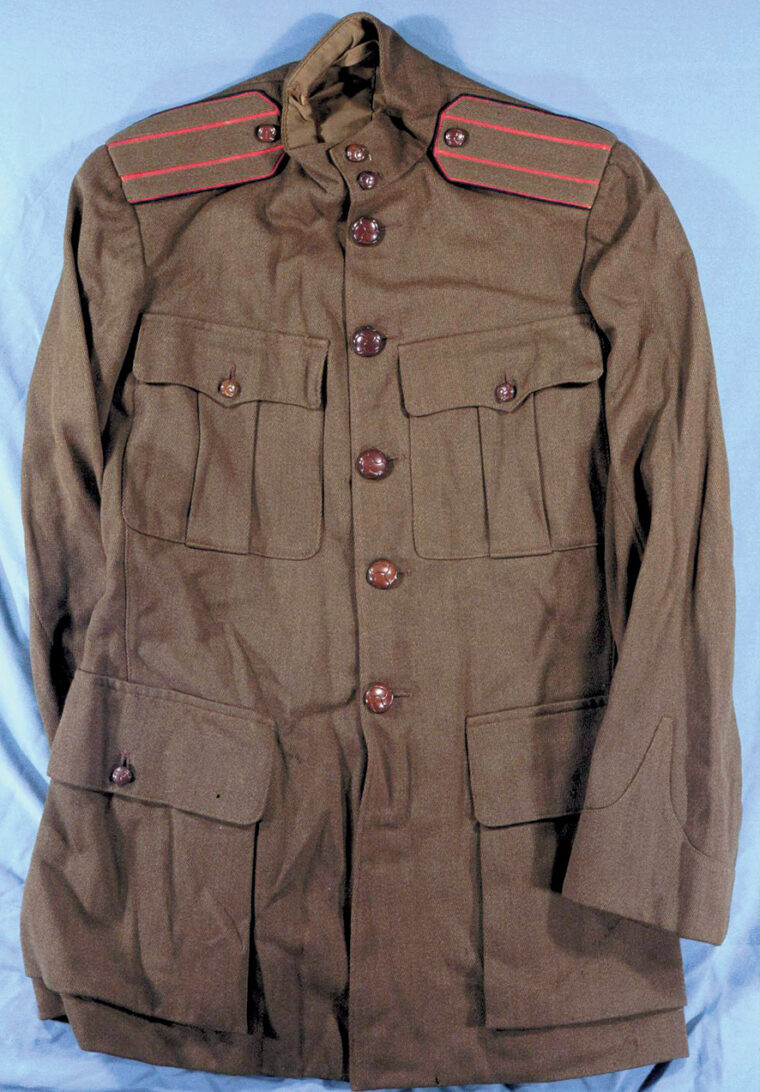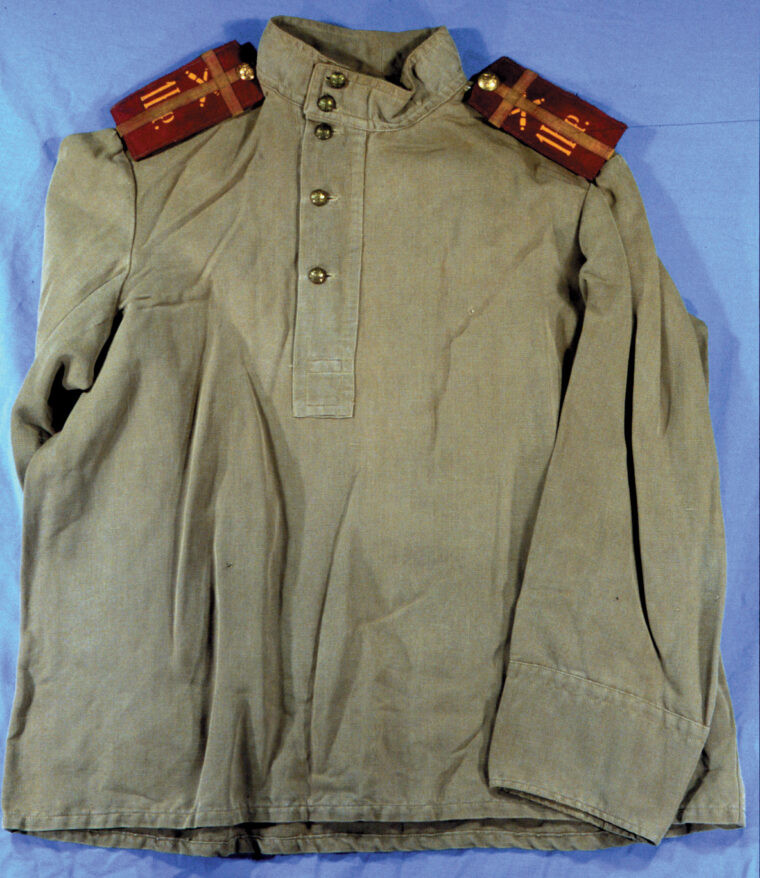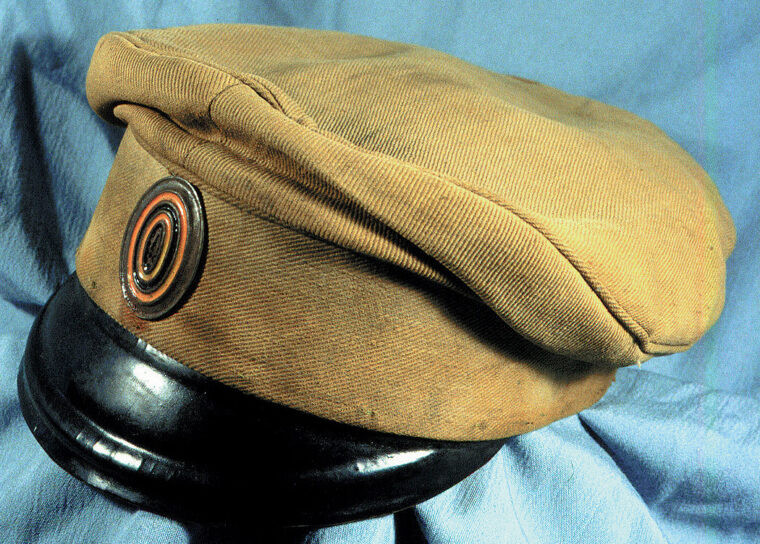The uniforms of the Imperial Russian Army during World War I offer a fascinating glimpse into the challenges and complexities faced by the Czarist military. While perhaps less documented than their Western counterparts, these World War 1 Russian Uniforms reveal much about the army’s organization, supply issues, and the conditions endured by soldiers on the Eastern Front.
The standard field uniform adopted by the Russian Army in 1907, prior to World War I, was a response to the lessons learned in the Russo-Japanese War. The need for camouflage was recognized, leading to the introduction of a khaki service coat, or kitel. This tunic featured a stand collar, a five-button front, and two lower pockets for enlisted men. Officers wore a similar kitel but distinguished by the addition of two breast pockets, signifying their rank.
Branch-of-service piping further differentiated officers’ world war 1 russian uniforms, adorning collars and cuffs. Cavalry officers were identifiable by an inverted “v” piping on their cuffs, while other officers had straight cuffs. The pre-war khaki, while officially described as such, leaned towards a green-gray hue. Officer uniforms were custom-made from superior materials, contrasting with the enlisted ranks’ uniforms which, while still of decent quality before the war, would see a decline as the conflict progressed.
In 1912, the gimnastorka, a field shirt, became standard issue across all ranks. This garment, made of wool for winter and cotton for summer, drew inspiration from traditional Russian peasant clothing. It featured a stand collar and a chest placket with two or three buttons, typically unlined.
 Russian cavalry colonel WWI French style field tunic
Russian cavalry colonel WWI French style field tunic
Initially, only officers’ gimnastorkas had breast pockets with flaps. However, in 1913, breast pockets were also authorized for enlisted men, although widespread issue during the war remains uncertain. Buttons on world war 1 russian uniforms, including gimnastorkas, could be metal with the Imperial double-headed eagle, bone, or even wood, reflecting variations in production and supply.
The gimnastorka, in particular, exhibited significant variations in style. Unlike the highly standardized uniforms of the German and British armies, world war 1 russian uniforms suffered from inconsistencies. Official patterns existed, but details like the number of placket buttons (two or three), collar buttons (one or two), cuff styles (plain or buttoned), pocket types (patch or internal, with or without flaps), and even the khaki color itself varied widely. Khaki shades ranged from brown to light tan, green, and gray. Later in the war, some officers adopted four-pocket gimnastorkas, mirroring their tunic style.
Officers’ tunics also displayed stylistic discrepancies in pocket design, button types, and other details. The pre-war kitel persisted, but variations arose in cuffs, pockets, and collars, contributing to the diverse appearance of world war 1 russian uniforms.
A notable wartime adaptation was the “French” style tunic, named after British General French. This tunic, inspired by British officer field tunics, became a common sight among Russian officers. Typically featuring a cotton lining and larger, often pleated pockets, the French tunic used various button types – standard size, bone, wood, leather, or the Imperial eagle, and sometimes oversized plain buttons. Like gimnastorkas, these tunics appeared in a range of khaki shades, further illustrating the lack of uniformity in world war 1 russian uniforms.
 Imperial Russian enlisted summer gimnastorka and field cap
Imperial Russian enlisted summer gimnastorka and field cap
The inconsistencies in world war 1 russian uniforms stemmed largely from the strained Russian supply system at the war’s outset. Anticipating a short conflict, initial supply planning was inadequate. Russian industry, composed of numerous small, geographically dispersed businesses, struggled to meet the immense demand. Subcontracting further diluted adherence to official uniform patterns, resulting in the widespread variations observed in world war 1 russian uniforms.
Variations extended beyond tunics and shirts to breeches and trousers. Both officers and enlisted men wore breeches and straight-leg trousers, with officers’ versions distinguished by two branch-piping stripes along the outer seam. While khaki breeches and trousers were officially mandated in varying shades, dark blue breeches, originally for peacetime, also saw wartime use, adding to the diversity of world war 1 russian uniforms.
Field caps, an essential part of world war 1 russian uniforms, were made from wool or cotton with a medium-height crown and a leather or composite visor in black or khaki. Officers and some enlisted ranks wore matching chinstraps. Caps were lined with polished cotton and had leather or leatherette sweatbands. Pre-war reinforcing rings in the crown were often removed in the field for comfort or practicality.
Shoulder straps were a defining feature of world war 1 russian uniforms, indicating rank and unit for both officers and enlisted men. Officer straps used metallic braid – gold for combat arms and silver for technical and support branches. Regimental or branch-of-service piping bordered and was woven into the braid. Stars denoted company-grade ranks, while field-grade officers (major to colonel) had progressively fewer stars. Generals wore solid metallic braid straps.
Enlisted men’s shoulder straps, pre-war, were in regimental or branch-of-service colors, sometimes double-sided with khaki reverses. Warrant officers and NCOs had braid stripes in different patterns. Unit numbers or ciphers, often Cyrillic letters, were displayed on all ranks’ straps – metal for officers, painted for enlisted men, further personalizing world war 1 russian uniforms.
Wartime regulations in 1914 mandated khaki shoulder straps for all ranks, eliminating branch-of-service colors but retaining unit ciphers and numbers. However, like other uniform components, shoulder straps exhibited manufacturing variations, making definitive authentication challenging for collectors of world war 1 russian uniforms.
 Enlisted summer field cap with cockade WWI Russian uniform
Enlisted summer field cap with cockade WWI Russian uniform
Footwear, particularly the iconic black leather boots, was another hallmark of the Russian soldier. However, the Russian quartermaster corps’ unpreparedness at the war’s beginning extended to boots. Shortages meant millions of mobilized soldiers lacked adequate footwear, mirroring shortages of rifles and world war 1 russian uniforms themselves. Massive boot purchases from the United States became necessary to address this critical deficiency.
Imported supplies, including boots and even khaki cloth from Great Britain (used for officer’s wool gabardine tunics), were crucial for the Russian war effort. Leather shortages also impacted the availability of basic field equipment for world war 1 russian uniforms.
Field equipment, while broadly similar to that of other armies, also presented variations. Enlisted men carried brown leather belts with wire or brass buckles, ammunition pouches, brass mess kits (pot-like and without tops), haversacks, canteens, and small shovels in leather carriers. Overcoats were rolled and worn over the shoulder. Officers carried belts with shoulder straps, swords, canteens, map cases, and pistols, typically carrying less additional kit compared to enlisted soldiers in world war 1 russian uniforms.
 Russian artillery officers WWI field uniforms equipment
Russian artillery officers WWI field uniforms equipment
The diversity in world war 1 russian uniforms and equipment, while historically interesting, poses challenges for collectors. Authenticity is difficult to ascertain due to the lack of a single, definitive pattern and the presence of copies, some originating from Soviet film studios. While studio stamps don’t automatically disqualify an item (as studios sometimes used originals), the quality of materials in copies is often inferior. Expertise in original world war 1 russian uniforms and attention to manufacturing details remain the best tools for determining authenticity.
Original Imperial Russian uniforms are scarce, even in Russia. Years of wear and tear decimated the millions produced before 1917. Ironically, Russian émigré communities abroad have sometimes proven to be better sources for these items than Russia itself.
Despite their rarity, world war 1 russian uniforms occasionally surface. Gimnastorkas or caps can fetch prices exceeding $350, while officer tunics can surpass $500. Militaria dealers specializing in World War I items or antique dealers focusing on Imperial Russian artifacts are the most likely sources. Online auctions also present opportunities, often with helpful illustrations. Direct examination and money-back guarantees are advisable when acquiring rare world war 1 russian uniforms.
In conclusion, world war 1 russian uniforms reflect the complex realities of the Imperial Russian Army – a force marked by both tradition and improvisation in the face of immense wartime pressures. Their variety, born from supply challenges and evolving battlefield needs, offers a rich and nuanced area of study for historians and collectors alike.

